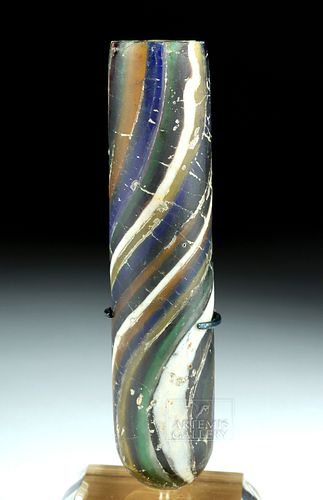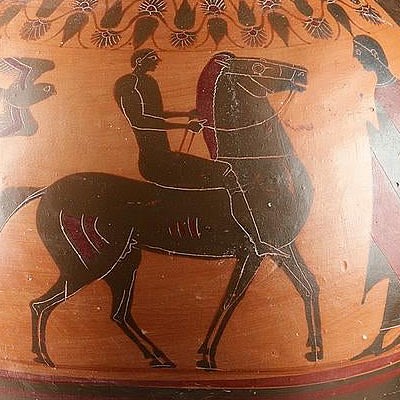Late Hellenistic Glass Polychrome Mosaic Vial
Lot 33b
About Seller
Artemis Fine Arts
686 S Taylor Ave, Ste 106
Louisville, CO 80027
United States
Selling antiquities, ancient and ethnographic art online since 1993, Artemis Gallery specializes in Classical Antiquities (Egyptian, Greek, Roman, Near Eastern), Asian, Pre-Columbian, African / Tribal / Oceanographic art. Our extensive inventory includes pottery, stone, metal, wood, glass and textil...Read more
Categories
Estimate:
$6,000 - $9,000
Absentee vs Live bid
Two ways to bid:
- Leave a max absentee bid and the platform will bid on your behalf up to your maximum bid during the live auction.
- Bid live during the auction and your bids will be submitted real-time to the auctioneer.
Bid Increments
| Price | Bid Increment |
|---|---|
| $0 | $25 |
| $300 | $50 |
| $1,000 | $100 |
| $2,000 | $250 |
| $5,000 | $500 |
| $10,000 | $1,000 |
| $20,000 | $2,500 |
| $50,000 | $5,000 |
| $100,000 | $10,000 |
| $200,000 | $20,000 |
About Auction
By Artemis Fine Arts
Jun 4, 2020
Set Reminder
2020-06-04 10:00:00
2020-06-04 10:00:00
America/New_York
Bidsquare
Bidsquare : Exceptional Antiquities, Asian, Ethnographic
https://www.bidsquare.com/auctions/artemis-gallery/exceptional-antiquities-asian-ethnographic-5185
An important one-day auction featuring museum-worthy examples of Egyptian, Greek, Roman, Etruscan, Near Eastern, Far East / Asian, Pre-Columbian, African / Tribal, Oceanic, Native American, Spanish Colonial, Russian, Fossils, Ancient Jewelry, Fine Art, so much more! Artemis Fine Arts info@artemisgallery.com
An important one-day auction featuring museum-worthy examples of Egyptian, Greek, Roman, Etruscan, Near Eastern, Far East / Asian, Pre-Columbian, African / Tribal, Oceanic, Native American, Spanish Colonial, Russian, Fossils, Ancient Jewelry, Fine Art, so much more! Artemis Fine Arts info@artemisgallery.com
- Lot Description
Greece, late Hellenistic period, ca. 1st century BCE. A gorgeous vial formed from swirling glass canes of black, white, clear, green, yellow, amber, red, and blue hues. The vessel boasts a thick composition and is defined by a rounded base, tall walls, a deep interior cavity, and a smooth rim. Vessels like this example were formed by wrapping glass canes of various colors around a central stick mold until the overall shape was formed, and the artisan would then cut away any excess and polish the rim with a red-hot flame. Faint areas of rainbow-hued iridescence are scattered around the rim and body and make this an attractive example of fine late Greek glasswork. Custom lucite display stand included. Size: 0.8" W x 3.8" H (2 cm x 9.7 cm); 4.375" H (11.1 cm) on included custom stand.
This vessel belongs to Oliver's type B alabastron type as described by Andrew Oliver, "Late Hellenistic Glass in the Metropolitan Museum," Journal of Glass Studies 9 (1967), pp. 20-22.
For a complete discussion of this type of vessel see also E. Marianne Stern and Birgit Schlick-Nolte, "Early Glass of the Ancient World, 1600 BC - AD 50: The Ernesto Wolf Collection" (Ostfildern, 1994), cat. no. 88, pp. 302-305.
For a stylistically-similar example with gold canes, please see "Solid Liquid: Greek, Roman, Byzantine and Islamic Glass." Fortuna Fine Arts, Ltd., New York, 1999, pp. 34-35, fig. 37.
Provenance: private East Coast, USA collection; ex-Martin Worsh collection, New York, USA, acquired in the 1980s
All items legal to buy/sell under U.S. Statute covering cultural patrimony Code 2600, CHAPTER 14, and are guaranteed to be as described or your money back.
A Certificate of Authenticity will accompany all winning bids.
We ship worldwide and handle all shipping in-house for your convenience.
#139588Surface wear and minor abrasions commensurate with age, some small but stable hairline fissures, and areas of pitting and light encrustations, otherwise intact and excellent. Scattered areas of rainbow iridescence, and nice earthen deposits throughout.Condition
- Shipping Info
-
All shipping is handled in-house for your convenience. Your invoice from Artemis Gallery will include shipping calculation instructions. If in doubt, please inquire BEFORE bidding for estimated shipping costs for individual items.
-
- Buyer's Premium



 EUR
EUR CAD
CAD AUD
AUD GBP
GBP MXN
MXN HKD
HKD CNY
CNY MYR
MYR SEK
SEK SGD
SGD CHF
CHF THB
THB














